Oh hey, the Taj Mahal? It’s this stunning white marble tomb by the Yamuna River in Agra, India. Seriously, one of the prettiest spots on Earth.
If you’re looking for a fun Taj Mahal story for kids in English, here’s how it goes. Quick backstory: In the 1600s, Emperor Shah Jahan was crazy in love with his wife, Mumtaz Mahal. She dies giving birth to their 14th kid, and he’s heartbroken.
So he pours everything into building her this epic memorial. We’re talking 22 years of work, 20,000+ people busting their butts, elephants hauling giant stones, and artists mixing Persian, Islamic, and Indian styles to make it perfect.
Gardens, gem inlays, the whole shebang. It even shifts colors with the sun—pink in the morning, gold at night. Sad twist though: his son jails him later, and he just stares at it from his cell till the end.
But man, what a tribute to love. If you go, it’ll blow your mind. Totally worth the hype as a world wonder!
Taj Mahal Story for Kids in English
Once upon a time, an emperor built the most beautiful palace ever, not for himself but for love. Here’s the Taj Mahal story for kids in English.
Story 1: The King Who Loved Deeply
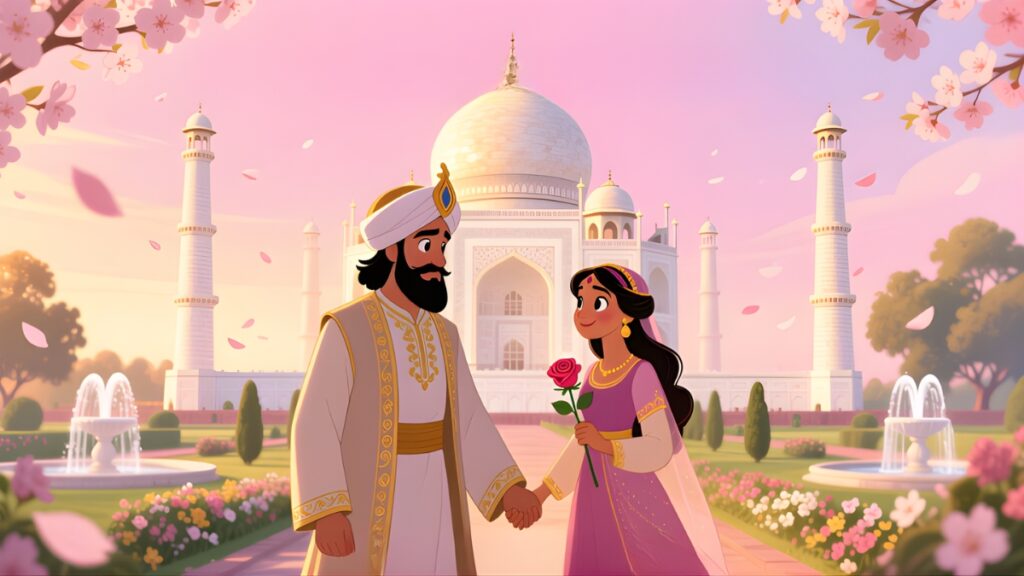
Long ago, there lived a Mughal emperor named Shah Jahan. He ruled a wide land and people said he was fair and liked beautiful things. He enjoyed gardens, soft cloth, and music at sunset. He laughed often with his family and liked to sit under trees when he could.
The person he loved most was his wife, Mumtaz Mahal. She moved quietly through rooms and markets and had a kind way of listening.
She visited the poor and helped them with food or blankets. Sometimes she rode beside the emperor on long journeys, and she would smooth his coat with a small, gentle hand when he looked worried.
One day, while Mumtaz was with Shah Jahan on a long trip, she grew very sick. The doctors tried to help, but she did not get better.
Before she died, she took Shah Jahan’s hand and asked him to care for their children. “Remember me kindly,” she said. He promised, holding her hand as if it were the most precious thing he had.
After she was gone, Shah Jahan did not feel like himself. He sat quietly, watching the moon and thinking of the sound of her laugh. He walked through quiet halls and touched the things she had used, like a little cup or a shawl. Those small things made him remember the warmth of her hands.
One night, under a clear sky, he said softly, “I will build something so beautiful that the world will remember her name.” That small promise began a long, slow dream. It was not just a plan. It was a way for him to keep her close even when he could not see her.
Story 2: Building the Dream
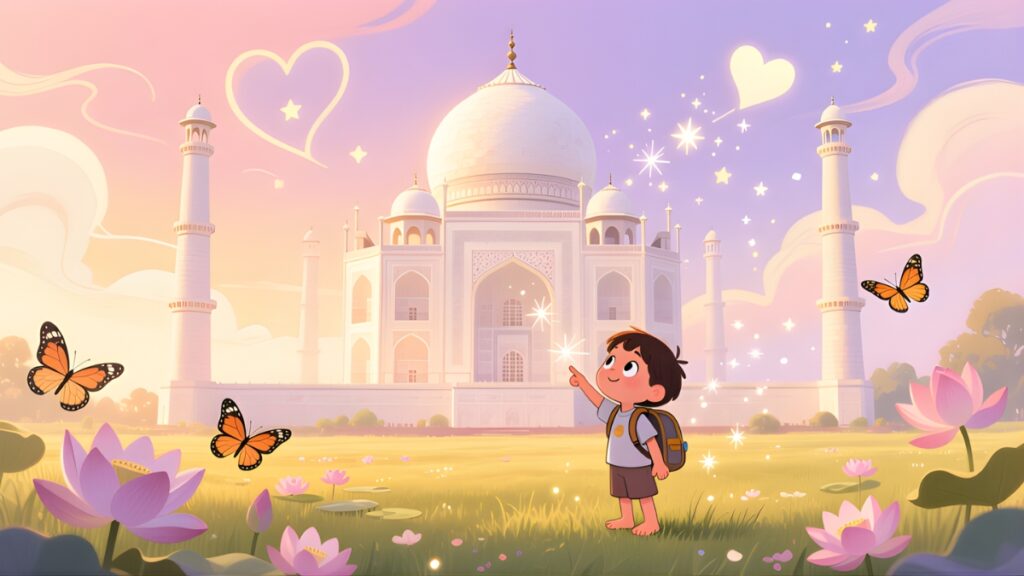
The emperor sent messengers to find the best builders and artists. They came from many places, from near and from far.
Stone carvers came with chisels, painters brought fine brushes, and gardeners knew how to plant trees so the paths would smell of flowers in spring.
The builders chose white marble from quarries in Rajasthan. When the sun touched that marble, it could look like milk, or like silk, or like a cloud.
They also used small colorful stones, red and green and blue, and cut them into tiny shapes. The stones were fitted into the marble to make flowers, vines, and birds that seemed alive when you stood close.
Work began early in the morning with the sound of hammers and the quiet rhythm of chisels. Men climbed wooden scaffolds that creaked a little. Women mixed lime and sand and spread plaster in thin layers.
Boats moved along the Yamuna River carrying heavy blocks. The river smelled faintly of mud and water plants.
Children from nearby villages watched and sometimes brought water or bread to the workers. At night the site glowed with lamps and the low voices of people telling old tales.
They used special tools to polish the marble until it shone. They used tiny pieces of colored stone and fit them into the white marble with careful hands.
This work is called inlay. Up close, the walls look like pictures made of little jewels. Sometimes a worker would pause, wipe his brow, and smile at a pattern that had come out just right.
It took more than twenty years and about twenty thousand people to finish. Some workers lived in tents near the site. Some families moved with the job. They shared food, songs, and jokes.
They taught children to grind stone dust and to hold the chisel gently so the marble would not crack. The work was long and careful because everyone knew they were making something meant to last.
When it was finished, Shah Jahan came early in the morning. He walked in the cool air and saw the domes glow like cream. He touched the marble and felt the smooth stone warm under his palm.
He stood for a long time, looking at the tiny flower shapes and the long reflection pools. Then he whispered, “This is my gift of love,” as if the building were a letter to the woman he missed.
Story 3: The Architect’s Secret
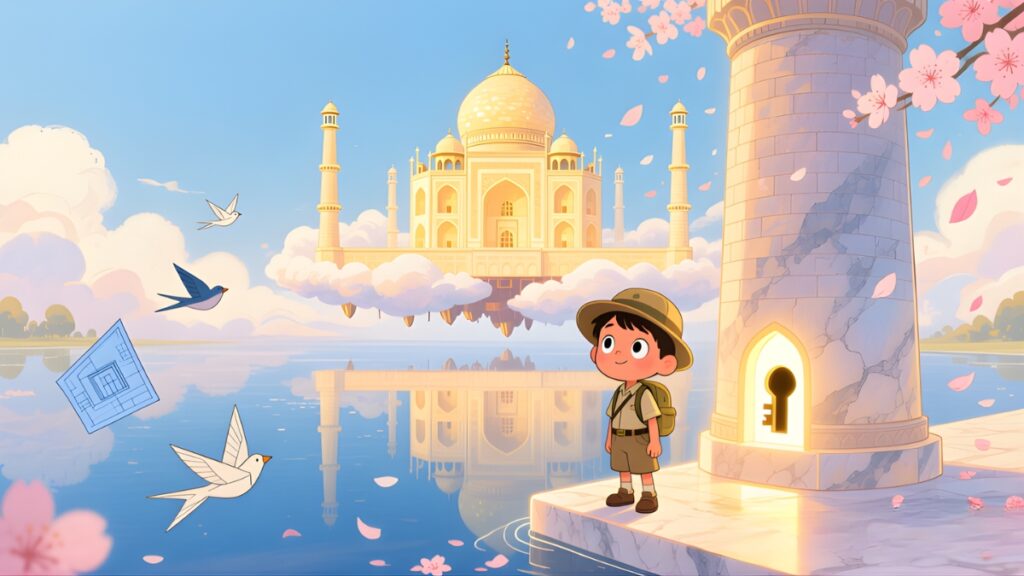
The chief architect is called Ustad Ahmad Lahori. People tell soft stories about him. He made many drawings and checked measurements again and again.
He taught young boys and girls who wanted to learn how to cut tiny letters and shape flowers out of stone.
When the emperor first saw the finished building, he felt something like a breath leaving his chest. “How did you make this?” he asked the architect.
Ustad Ahmad smiled and said, “I listened to the wish in your heart. I drew what you could not say.” He did not speak of gold or praise. He spoke of working with hands that wanted to make one place gentle enough for a memory.
The architect worked with many helpers. Some measured the heights and made sure both sides were the same. Others carved the black letters that circle the doors.
The letters are from holy books and they were carved so carefully that they look the same size all the way up the wall. Young apprentices learned to polish the stone until it reflected light like a calm pool.
Some small stories say the architect walked the site at dawn with a cup of tea and watched how birds landed on the garden paths.
Whether those tales are true or not, they remind us that careful plans and patient hands make beauty that lasts.
Story 4: The River’s Whisper
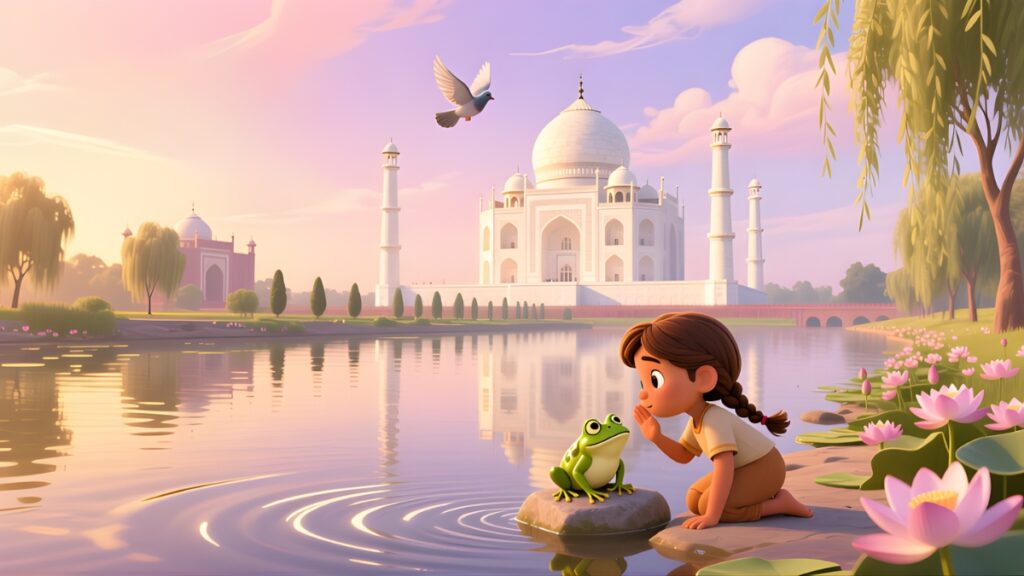
The Taj Mahal sits next to the Yamuna River. The river moves slowly and keeps its own quiet. On misty mornings the white marble looks wrapped in fog. At night the moon paints the building in soft silver.
One old tale says Shah Jahan once stood by the river and thought he heard it whisper. The breeze moved the leaves and the water answered with a small, soft sound.
The emperor felt that the river would carry the story of the palace and the story of Mumtaz Mahal far down the valley.
To make the place feel like water and stone belonged together, the builders made long pools and narrow channels. The pools are lined with low stone edges and small fountains. When the air is still the pools show a perfect picture of the domes.
Visitors sometimes stand very quiet and watch the reflection, and for a moment the building seems to float, like a dream shown twice.
There are also four tall towers called minarets at the corners. They stand like guardians and make the shape look calm and strong.
The minarets were built a little away from the main building so they would not touch it if the earth ever moved. People pass under them and feel small next to the tall, straight stones that reach up to the sky.
Story 5: A Visit from a Little Girl
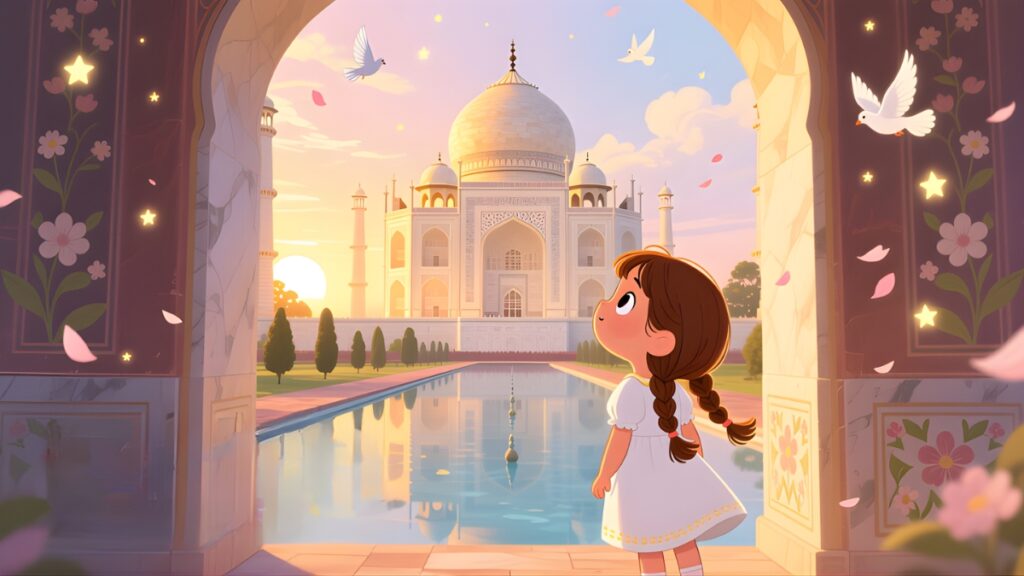
Hundreds of years later, a little girl came to the Taj Mahal with her grandfather. They walked along the wide path between low hedges.
The air smelled of roses and jasmine. The girl held her grandfather’s hand and asked questions with quick, bright eyes.
When she first saw the domes she whispered, “Grandpa, it looks like a castle made of clouds.” Her grandfather laughed softly and told her the story of Shah Jahan and Mumtaz Mahal.
He used small words and gentle pauses so she could picture the boats and the chisels and the quiet hands that set tiny stones into the marble. He told her how people worked together and how the emperor kept his promise.
When the story ended, the girl looked at the marble and said, “He must have really loved her.” Her grandfather nodded and smiled with eyes that had seen many sunrises.
“Yes,” he said. “People come here to see more than stone. They come to feel a love that wanted to be remembered.”
The girl sat on a low step and traced a carved flower with her fingertip. She found a small, smooth place and pressed gently. The marble felt cool and quietly strong. For a moment she felt held by the place itself, as if the story had wrapped around her like a warm shawl.
Story 6: The Colors of the Sky
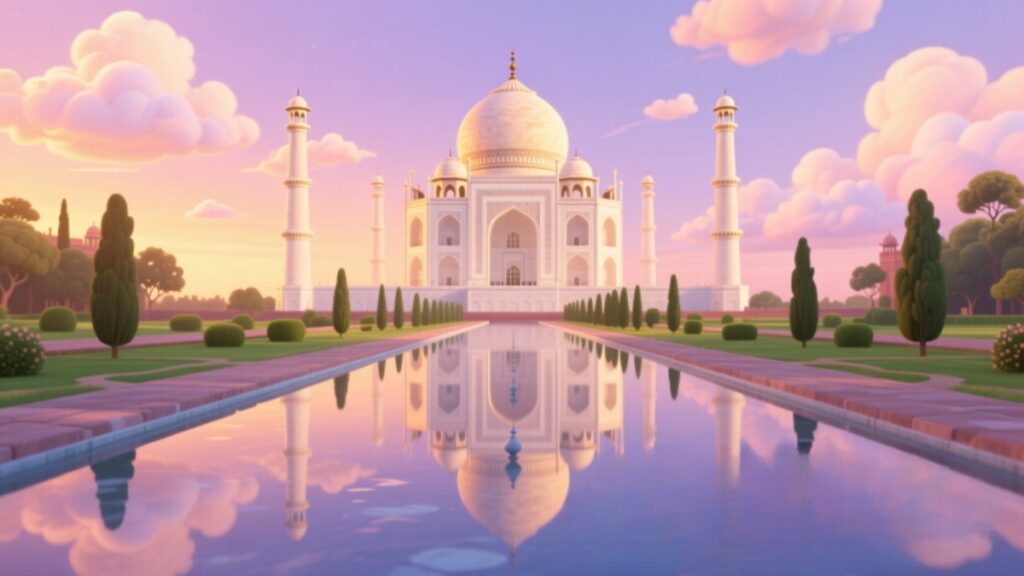
Every day, the Taj Mahal changes its colors like a shy dancer under the sun. In the early morning, it glows soft pink, like the inside of a seashell.
At noon, it shines white and bright, almost too dazzling to look at. When the sun begins to fall, it turns golden, and by night, it becomes silver under the moon.
People say the Taj Mahal wears the sky’s feelings. When the sky is cloudy, the marble looks dreamy and gray. When the stars appear, it seems to breathe with light.
Long ago, Shah Jahan used to sit by his window and watch these colors. Even though he could no longer walk by the river, he still watched the palace he built for love. The colors reminded him of her voice, sometimes soft, sometimes bright, always full of warmth.
Visitors today still stand quietly to see how the light dances on the walls. Children point and say, “It’s glowing!” and grown-ups smile because they see it too. The Taj Mahal teaches everyone that love, like light, changes but never disappears.
Story 7: The Promise That Stayed
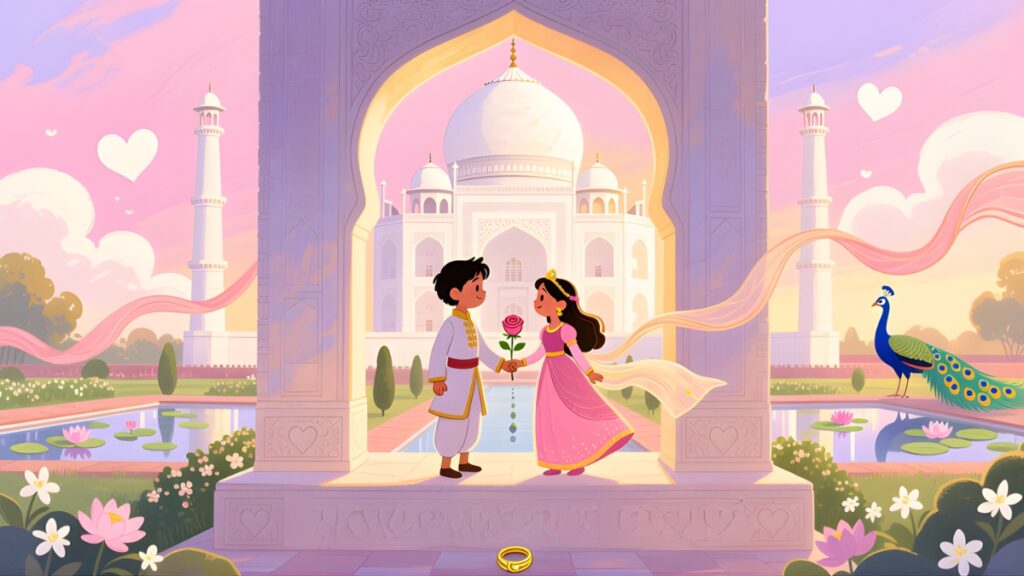
Years passed after Shah Jahan left this world, but the Taj Mahal stayed. The marble did not forget. The gardens still bloomed, the fountains still rose, and the river still whispered beside it.
People came from faraway lands to see it. Some came to draw, some came to pray, and some just stood in silence. They touched the cool stone and felt the promise that built it.
One evening, a young couple visited. The woman smiled and said, “Imagine loving someone so much that you build this for them.” The man nodded and said softly, “Maybe love is the only thing that can last this long.”
As the moon rose, the Taj Mahal glowed pale and calm. The couple walked away holding hands. Behind them, the palace stood quietly, keeping its promise.
And so, even after hundreds of years, the story still lives — told in white marble, shining beside the river, reminding everyone that love can build things stronger than time.
What Makes the Taj Mahal So Special
The Marble
It shines white in daylight, becomes warm and pink at sunrise, and looks silver under the moon. The color seems to change with the sky. The marble is very smooth in places, so you can almost see your own face in it.
The Garden
It is divided into four parts to show balance and peace. Trees and fruit plants are placed so paths smell sweet in the morning. In the old stories these gardens were meant to be a little piece of heaven on earth.
The Art
Tiny colored stones are cut and set into the marble to make flowers and patterns. This inlay work is made by fitting each little piece perfectly so the design does not fall apart. Up close the walls look like paintings made of jewels.
The Words
Verses from the Quran are carved around the doors. The letters are cut so carefully that they look the same size from top to bottom. The black writing frames the doors and makes the stone feel softer.
The Reflection Pools
Long water channels mirror the building so it seems to float on water. When the wind is still the reflection is very clear. The pools were planned so the building and the water could speak to each other.
The Minarets and Domes
The domes curve gently and the minarets stand tall at the corners to balance the whole shape. The domes make a quiet bell shape that the eye likes to follow. The minarets make the whole place feel calm and steady.
Small Details
Look for carved flowers, tiny birds, and smooth steps. See how some patterns repeat like a small song. The artisans made each small part with care, as if sewing a picture with stone.
Real Facts (Short and Clear)
- Location: Agra, India
- Built by: Emperor Shah Jahan
- For: Mumtaz Mahal
- Started: Around 1631
- Finished: Around 1653
- Workers: About 20,000 people
- Architect: Ustad Ahmad Lahori
- Style: Mughal architecture, a mix of Indian, Persian, and Islamic art
- Status: UNESCO World Heritage Site and one of the New Seven Wonders of the World
A Note: Many people who visit also learn that Shah Jahan was later buried near Mumtaz Mahal. Their graves lie quietly inside the building so their story rests there together.
What the Taj Mahal Teaches Us
The Taj Mahal is more than a building. It shows that an idea, a promise, or a feeling can become something that people can see and touch.
It teaches children that patient work, a team of people, and careful hands can turn a dream into something real. It reminds us to love the people close to us and to make things that help others remember.
It also shows that small details matter, that a careful hand can make a small flower in stone that will last for many years.
Questions You Can Ask After Reading
- What part of the story did you like best?
- If you could visit the Taj Mahal, what time of day would you go, morning, noon, or night?
- What color do you imagine the marble when the moon is full?
- Why do you think Shah Jahan built it beside a river?
- Which small detail would you look for first, a flower in the stone, a carved letter, or the reflection in the pool?
Activities for Kids
Draw the Taj Mahal
Use white, light blue, and pink to show how the marble changes color. Add a little river in front and draw your reflection.
Story Map
Draw the river, gardens, domes, and towers, and then draw lines to show where you would walk. Mark a place where you would sit and listen.
Write a Letter
Pretend you are Shah Jahan and write a short letter to Mumtaz Mahal. Use gentle words and tell her what you plant in the garden.
Build It
Use clay, blocks, or cardboard to make your own small Taj. Try making tiny flowers with colored paper and glue them on.
Act It Out
Take roles: the king, the queen, the builder, the river. Speak softly when the river whispers its story.
Tiny Pattern Hunt
Look at a picture of the Taj and circle five different small details. Try to draw one of those details bigger on paper.
Visiting Tips for Families
- Go early in the morning or at sunset, the light is soft and the air is calm. These times show the marble in gentle colors.
- Bring water, hats, and sunscreen. The sun can feel warm on the open garden paths.
- Walk slowly through the garden and listen, birds, footsteps, and the river make a quiet music. If you walk slowly you will notice small things.
- Look closely at the marble walls, you will see tiny flowers made of colored stones. Take turns with children to point out a new detail each time.
- Take a moment to stand still and feel the peace. Sit by the reflection pool and watch the domes in the water.
Final Thoughts
The Taj Mahal is a story carved in stone. People who come here see many things, beauty, sadness, hope, and a kind of quiet magic.
Most of all, they see a promise kept, a man who turned love into art so one name would not be forgotten. The place keeps small sounds and small stories.
Each visitor adds one more quiet step to those stories, and so the building lives not only in stone but in the memory of everyone who walks its path.




